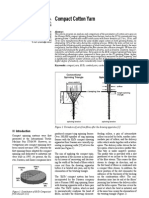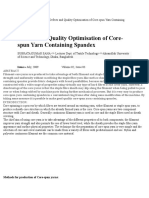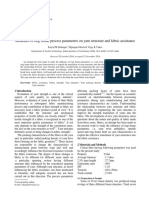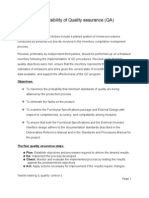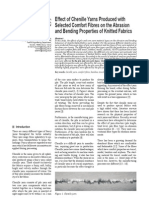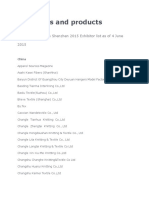Ring Can
Ring Can
Uploaded by
Mitu ChowdhuryCopyright:
Available Formats
Ring Can
Ring Can
Uploaded by
Mitu ChowdhuryOriginal Description:
Copyright
Available Formats
Share this document
Did you find this document useful?
Is this content inappropriate?
Copyright:
Available Formats
Ring Can
Ring Can
Uploaded by
Mitu ChowdhuryCopyright:
Available Formats
Thesis Title:
The effect of total draft, draft distribution, and twist on the quality of 100% combed cotton yarns
and 50/50 polyester/cotton yarns spun on the Suessen Ringcan sliver-to-yarn spinning system
Thesis Author:
F. Mark Stone, ITT, NCSU, USA
Abstract: A major disadvantage of the ring spinning system from both an economic and quality
standpoint is the necessity to use roving as an extra process prior to spinning. Although the use of
sliver at the ring frame has been attempted numerous times in the past, the concept has never
been commercially- accepted,-attributed- to the complex drafting-systems of earlier systems and
their inability to properly creel the sliver. At the 1991 International Textile Machinery
Association (ITMA) show in Hanover, Germany, Spindelfabrik Suessen introduced the RingCan
spinning system for the production of ring yams directly from sliver. The RingCan system uses
an uncomplicated three roll drafting unit to attain drafts up to 200 times, and Suessen has
attempted to solve the problem of creeling by using a conveyor to transport the sliver from the
draw can to the back of the draft zone without false draft. This work provides an independent
analysis of the Suessen RingCan system with a direct comparison to yams spun on a
conventional ring system. To accomplish this work, 30s Ne yams were spun from both 100%
combed cotton and 50/50 poly/cotton. Three levels of total draft in combination with three levels
of break draft and two levels of twist multiplier were used to evaluate their effect on yam quality.
Yam tests within the Institute's Monthly Quality Check (MQC) program were performed on each
experimental condition to evaluate the physical characteristics of the yam, and the yams were
then knit into single jersey fabric to evaluate the physical and aesthetic characteristics of the
yams in a knitted fabric. The results of this work showed that yams spun on the Suessen RingCan
sliver-toyam system were comparable in quality to yams spun on a conventional ring spinning
frame, with some characteristics being better. Considering experimental limitations, and with
respect to the objectives of this thesis, the following general conclusions were derived: 1. The
quality characteristics of yarn spun on the Suessen RingCan frame are affected by total draft, but
the effect is sometimes influenced by the level of break draft and twist multiplier. 2. The quality
characteristics of -yarn spun on the SuessenRingCan frame are affected by break draft, but the
effect is sometimes influenced by the level of total draft and twist multiplier. 3. The quality
characteristics of yarn spun on the Suessen RingCan frame are affected by the level of twist
multiplier, but the effect is sometimes influenced by the level of total draft and twist multiplier.
4. In general, yarns spun on the Suessen RingCan frame are superior in quality to those produced
on a conventional ring spinning frame. (a) Comparisons made within twist levels showed the
100% combed cotton yarns were superior in strength, elongation, yarn appearance, evenness,
imperfections, shrinkage, and fabric appearance. The low twist sliver-to-yarn conditions were
superior to the high twist conventional conditions in appearance, evenness, imperfections and
fabric bursting strength. (b) Comparisons made within twist levels showed the 50150 combed
cotton yarns were superior in strength, elongation, evenness, imperfections, fabric appearance
and fabric bursting strength. The low twist sliver-to-yarn conditions were superior to the high
twist conventional conditions in strength, appearance, evenness, and imperfections.
Source: NCSU, www.itt.edu
You might also like
- 1.25-Improve Yarn Quality - Reduce HairinessNo ratings yet1.25-Improve Yarn Quality - Reduce Hairiness4 pages
- Evaluating the Unevenness of Stretch-Broken Tow inNo ratings yetEvaluating the Unevenness of Stretch-Broken Tow in6 pages
- Effect of Cotton Yarn Imperfection Index On CSPNo ratings yetEffect of Cotton Yarn Imperfection Index On CSP4 pages
- Comparative Study of The Quality Parameters of Knitted Fabrics Produced From Sirospun, Single and Two-Ply Yarns100% (1)Comparative Study of The Quality Parameters of Knitted Fabrics Produced From Sirospun, Single and Two-Ply Yarns5 pages
- Defects and Quality Optimisation of Core-Spun Yarn Containing Spandex100% (1)Defects and Quality Optimisation of Core-Spun Yarn Containing Spandex9 pages
- Seams and Sewing Thread Characteristics in Denim FabricNo ratings yetSeams and Sewing Thread Characteristics in Denim Fabric11 pages
- Analysis of Plain Single Jersey Fabric & Its DerivativesNo ratings yetAnalysis of Plain Single Jersey Fabric & Its Derivatives8 pages
- A Comparative Study On Egyptian Carded CNo ratings yetA Comparative Study On Egyptian Carded C13 pages
- 1997-Resilience Properties of Polypropylene CarpetsNo ratings yet1997-Resilience Properties of Polypropylene Carpets7 pages
- Influence of Blending Method and Blending Ratio On Ringspun Yarn Quality A MANOVA ApproachTekstilecNo ratings yetInfluence of Blending Method and Blending Ratio On Ringspun Yarn Quality A MANOVA ApproachTekstilec13 pages
- Determination of Yarn Tensile Strength - Textile LearnerNo ratings yetDetermination of Yarn Tensile Strength - Textile Learner14 pages
- Textile Testing & Quality: Title: To Determine The Skewness of The Given FabricNo ratings yetTextile Testing & Quality: Title: To Determine The Skewness of The Given Fabric6 pages
- OPTIMUM DRAFTING CONDITIONS OF POLYESTER AND VISCOSE BLEND YARNSNo ratings yetOPTIMUM DRAFTING CONDITIONS OF POLYESTER AND VISCOSE BLEND YARNS6 pages
- Effects of Enzymatic Treatment On Various Spun Yarn Fabrics: Nilgün Özdil, Esen Özdoğan, Tülin ÖktemNo ratings yetEffects of Enzymatic Treatment On Various Spun Yarn Fabrics: Nilgün Özdil, Esen Özdoğan, Tülin Öktem4 pages
- Introduction To Weaving Preparatory ProcessesNo ratings yetIntroduction To Weaving Preparatory Processes21 pages
- Development in Sizing Machine: By: Tanveer Malik, P.K.Roy & H.K.SinghNo ratings yetDevelopment in Sizing Machine: By: Tanveer Malik, P.K.Roy & H.K.Singh24 pages
- Measurement of Seam Puckering and Influence of Its Causes: Sandun Fernando Tss JayawardenaNo ratings yetMeasurement of Seam Puckering and Influence of Its Causes: Sandun Fernando Tss Jayawardena7 pages
- Influence of Weave Design and Yarn Types On Mechanical and Surface Properties of Woven FabricNo ratings yetInfluence of Weave Design and Yarn Types On Mechanical and Surface Properties of Woven Fabric4 pages
- Effect of Chenille Yarns Produced With Selected Comfort Fibres On The Abrasion and Bending Properties of Knitted FabricsNo ratings yetEffect of Chenille Yarns Produced With Selected Comfort Fibres On The Abrasion and Bending Properties of Knitted Fabrics6 pages
- Studies On Elastane-Cotton Core-Spun Stretch Yarns and Fabrics: Part I Yarn CharacteristicsNo ratings yetStudies On Elastane-Cotton Core-Spun Stretch Yarns and Fabrics: Part I Yarn Characteristics7 pages
- The Impact of Short Fiber Content On The Quality of Cotton Ring Spun YarnNo ratings yetThe Impact of Short Fiber Content On The Quality of Cotton Ring Spun Yarn11 pages
- Investigation Into Navel Selection For Rotor SpinnNo ratings yetInvestigation Into Navel Selection For Rotor Spinn6 pages
- Textile Testing & Quality: Title: To Determine The Bowing of The Given Fabric100% (1)Textile Testing & Quality: Title: To Determine The Bowing of The Given Fabric6 pages
- Theory of Silk Weaving A Treatise on the Construction and Application of Weaves, and the Decomposition and Calculation of Broad and Narrow, Plain, Novelty and Jacquard Silk FabricsFrom EverandTheory of Silk Weaving A Treatise on the Construction and Application of Weaves, and the Decomposition and Calculation of Broad and Narrow, Plain, Novelty and Jacquard Silk Fabrics5/5 (1)
- Net Making Made Simple - A Guide to Making Nets for Sport and HomeFrom EverandNet Making Made Simple - A Guide to Making Nets for Sport and HomeNo ratings yet
- C. A. Bouman: Digital Image Processing - January 9, 2017No ratings yetC. A. Bouman: Digital Image Processing - January 9, 201730 pages
- Analysis of Physical Characteristics of BambooNo ratings yetAnalysis of Physical Characteristics of Bamboo5 pages
- Wonder Woman Amigurumi Doll: Materials NeededNo ratings yetWonder Woman Amigurumi Doll: Materials Needed4 pages
- Bbcopie de Gildan Publicly Disclosed Locations - May 2024 FinalNo ratings yetBbcopie de Gildan Publicly Disclosed Locations - May 2024 Final8 pages
- Trika Exports: Dhairya Patel (18bba) Mansi Panchal (18bba) Payal Panchal (18bba)No ratings yetTrika Exports: Dhairya Patel (18bba) Mansi Panchal (18bba) Payal Panchal (18bba)11 pages
- A Study On Lead Time Management in The Garments Industry of BangladshNo ratings yetA Study On Lead Time Management in The Garments Industry of Bangladsh14 pages
- Cactus Crochet Pattern: Size: 14 CM (5.5 Inch) Tall Materials100% (1)Cactus Crochet Pattern: Size: 14 CM (5.5 Inch) Tall Materials5 pages
- Effects of Combed and Carded Yarn On Weft Knitted Finished Fabric QualityNo ratings yetEffects of Combed and Carded Yarn On Weft Knitted Finished Fabric Quality7 pages
- US-QUAL - F-QUAL-8.2 Section 8.2 Deviation Request Form January 2023 BlockedNo ratings yetUS-QUAL - F-QUAL-8.2 Section 8.2 Deviation Request Form January 2023 Blocked32 pages
- Fibre To Fabric: Name - Lalit Kumar Class - VI-E Roll No-20No ratings yetFibre To Fabric: Name - Lalit Kumar Class - VI-E Roll No-2011 pages









